Developing an Alternative Calculation Method for the Smart Readiness Indicator Based on Genetic Programming and Linear Regression
Abstract
1. Introduction
- The ability to respond adaptively to the demands of the occupants.
- The ability to facilitate maintenance and ensure optimal performance.
- The ability to adapt in response to the energy grid circumstances [10].
2. Methods
2.1. Experimental Setup and Data Collection
2.2. Research Design and Data Preparation for Modelling
3. Modelling
3.1. Modelling Domains Using GP
create staring population P(t)
evaluate starting population P(t)
continue
change P(t) -> P(t + 1)
evaluate P(t + 1)
t = t + 1”
These steps are repeated until the stopping criterion is met.
- “addition (+)”;
- “subtraction (–)”;
- “multiplication (*)”;
- “and division (/)”.
- “tournament size for selection operation 6.0”.
- “maximal permissible depth in the creation of the population: 30”.
- “maximal permissible depth after the operation of crossover: 20”.
- “reproduction probability [%]: 0.7”.
- “crossover probability [%]: 0.2”.
- “number of organisms: 500”.
- “tournament selection method with tournament size: 7”.
- “number of independent runs: 50” [54].
3.1.1. Score Prediction Model for the Heating Domain
(+ (+ (+ (− (* (− H33 H2D5) H2B3) (− (+ H1C2 H31) (* (− 7.16973 (+ 5.81691 H2D1)) (* (− (− (+ (− H33 H2D2) H2B3) (− (+ H1C2 (+ (* H2D5 H1A5) H31)) (* (− 7.16973 (+ 5.81691 H2D1)) 7.16973))) (− (+ (* (− (+ (− H33 H2D2) H2B3) (− (+ H1C2 H31) (* (− 7.16973 (+ 5.81691 H2D1)) H2D2))) (− H33 H1B2)) H44) (− (* H2D5 H2B3) (− (+ H1C2 H31) (− (+ H33 (+ H1C2 H2B3)) (− (+ (+ (* H2D5 H33) (+ H1A5 (+ (* H2B1 H1A4) H33))) (+ H1A5 (+ (+ (% H2B1 H1A5) H1A4) H31))) (* (% (+ (− H33 9.66955) (− (* H2D5 H2B3) (− (+ H1C2 (− (+ H1C2 (− (* (% H2D2 (+ (* H2B1 H2D2) H2D1)) (+ H1C2 (+ (* H2D5 H1A5) H31))) H31)) (* (+ (* H2B1 H1A4) H2D1) H31))) H2D2))) (+ (− (+ H1C2 (− H31 H31)) (* (% H2D2 H2D1) H2D2)) H2D1)) H2D1))))))) H35)))) (+ (− (* H2D5 H2B3) (− (+ H1C2 (− (+ H1C2 H31) (* (− 7.16973 (+ (+ 9.66955 H2B1) (+ (% H2B1 H1A4) H2D1))) H31))) (* (− (− (+ (− H33 H2D2) H2B3) (− (+ H1C2 H31) (* (− 7.16973 (+ 5.81691 H2D1)) 7.16973))) (− (+ (* (% H1F1 H2D2) (− H33 H1B2)) H44) (− (* H2D5 H2B3) (− (+ H1C2 H31) (− (+ (* (% H2D2 (+ (* H2B1 H2D2) H2D1)) H33) (+ (% H2B1 H1A5) H2B3)) (− (+ (+ H33 (+ H1A5 (+ (* H2B1 H1A4) H33))) (+ H1A5 (+ (* H2B1 H1A4) H31))) (* (% (+ 9.66955 (− (* H2D5 H2B3) (− (% H2D2 (+ (* H44 H2D2) H31)) H2D2))) (+ H1C2 H2D1)) H2D1))))))) H1A4))) (+ 9.66955 (− (* H2D5 H2B3) (− (+ H1C2 H31) (* (% H2D2 (+ (* H2B1 H2D2) H2D1)) 5.46992)))))) H2B2) (+ 5.81691 9.83727)))
3.1.2. Score Prediction Model for the Domestic Hot Water Domain
(* (− (+ (% (+ (% (% DHW1D1 DHW2B5) DHW1A4) (+ DHW1B1 DHW2B5)) DHW1A4) (+ (% −3.14511 DHW1B1) DHW1D3)) (− (% −3.14511 (* (% DHW1D1 DHW1A2) DHW1B3)) (− (+ DHW2B1 9.18609) DHW32))) (* (% (* (− DHW1D3 (− (% −3.14511 DHW1B3) (− (+ DHW2B1 9.18609) DHW32))) (* (% (% (% (− (* (% DHW1D1 DHW1A2) DHW1D1) DHW1A4) (% (+ DHW31 DHW2B2) DHW34)) (+ DHW2B1 DHW1D3)) (* (* DHW1A4 DHW1B1) (+ DHW31 (* (% (% DHW34 (% −3.14511 DHW1D3)) (* (* DHW1A4 DHW1B1) (+ DHW31 (+ DHW2B1 DHW2B5)))) DHW2B5)))) DHW1D3)) (* (* DHW1A4 DHW1B1) (+ DHW31 (− (+ DHW2B1 9.18609) DHW2B5)))) 3.21647)))
3.1.3. Score Prediction Model for the Cooling Domain
(* (− (+ (− (+ C1B2 C2A1) 7.66353) (+ (* (* C1A4 (% (* (* C1A4 C1F1) C34) (+ (− C1F1 C43) (* C1A4 (+ 7.66353 C1F1))))) C43) C1F3)) (− C1D3 C1D1)) (− (+ (− (− (+ (− (+ (− C2A1 7.66353) (+ C43 (− C1F1 C1F3))) (− (* (+ C43 (− C2A1 C1F1)) C1D3) (+ C1D5 (% (* (+ (− (+ (− (% (* (* C1A4 C1F1) C34) (+ (− C1F1 C43) (* C1A4 (+ 7.66353 C2A1)))) 7.66353) (+ (+ C43 (+ C43 (− C1F1 C43))) (− C1F1 C1F3))) (− C1D3 (+ C1D5 (% (* (* C1A4 (+ (− C2A1 7.66353) (+ C43 C1F1))) C34) 7.66353)))) (+ C43 (− C2A1 C1F1))) (+ C43 C34)) 7.66353)))) (+ (− C1F1 C43) (− C1F1 C1F3))) (− C1D3 (+ C1D5 (% (+ (− C1F1 7.66353) (+ C43 (% (+ (− C1F1 7.66353) (+ C43 C34)) (+ (− C1F1 C43) (* C1A4 (+ 7.66353 (+ C43 (+ C43 C34)))))))) (+ (− C1F1 C43) (* C1A4 (+ 7.66353 (+ C43 (+ C43 C1F3))))))))) (− C1D3 (+ C1D5 (% (* (+ C1D5 C1F1) C34) 7.66353)))) (+ C43 (− C1F1 C1F3))) (− C1F1 C31))))
3.1.4. Score Prediction Model for the Ventilation Domain
(+ (+ (+ (+ (* (* (% (− 8.4716 (% (− V31 −5.25128) (% (* (% V2C2 V1C5) V2D2) (+ V1C3 V1A3)))) V62) V33) V64) (− 8.4716 (% (+ (* (− (* (% V64 V33) (− V31 (% (* (% V2C2 V1C5) V2D2) (* (* (% (− 8.4716 (% (* (− V2C3 (− V1C2 V1C2)) (% (* (% V2C2 V1C5) V2D2) (+ V1C3 −5.25128))) (% (* (% V2C2 V1C5) V2D2) (+ V1C3 V1A3)))) V62) V33) V1C1)))) (% V1A2 (+ (* (− (* (− (* V61 (+ V1C3 (% (* (% V2C2 V1C5) V2D2) (+ V1C3 V2C3)))) (− V1C2 V61)) (− 8.4716 (% (− V31 (% (* (− 8.4716 (% (* (− (* V61 (+ V1C3 V2C3)) (− V1C2 V1C2)) (% (* (% V2C2 V1C5) V2D2) −5.25128)) V1C5)) V2D2) (+ V1C3 −5.25128))) (% (* (% V2C2 V1C5) V2D2) (+ V1C3 V2C3))))) V1C2) V1A5) V1A5))) V2D3) (* (% (− 8.4716 (− 8.4716 (% (− V31 −5.25128) (% (* (% V2C2 V1C5) V2D2) (+ V1C3 V1A3))))) V62) −5.25128)) (% (% (− (% V64 V1C1) (% V1A2 (% V1A2 (+ (* (* (% (− 8.4716 (% (* (− V2C3 (− V1C2 V1C2)) (% (* (% V2C2 V1C5) V2D2) (+ V1C3 −5.25128))) (% (* (% V2C2 (+ V1C3 V1C5)) V2D2) (+ V1C3 V1A3)))) V62) V33) V1A5) V2C1)))) (% (% V2D1 (+ V1A2 (− 6.96117 V2D1))) V2D2)) V1C4)))) (− (+ V64 (− 8.4716 (% (− V31 (% (* (% V2C2 V1C5) V2D2) (+ V1C3 −5.25128))) (% (* (% V2C2 V1C5) V2D2) (− 8.4716 (% (+ (* V1A5 V2D3) −5.25128) (% (% (* (+ V34 V1A3) (% V64 V2D2)) (% V2C2 (+ V64 (* (+ (* V1A5 V2D3) 1.53678) V2D2)))) 6.96117))))))) V61)) (− 6.96117 V33)) V1C2))
3.1.5. Score Prediction Model for the Lighting Domain
(* (* (% (− L25 L1A3) (* (− (− (+ L21 (* (* (% (+ (+ L23 L23) L1A3) L1A1) 3.27069) (− L25 L1A4))) L24) L22) L1A1)) (− (− L25 L22) (+ (− (* (+ (− (− L25 L25) L23) (+ (+ L23 L23) L22)) −0.160899) (* (* (% (− L25 L1A3) L1A1) (+ L23 3.27069)) (% L24 (+ L1A4 L21)))) (− (* (+ (+ L23 L23) L22) −0.160899) (* (% (% (+ L23 L1A3) (− L25 L1A3)) L1A1) (− (+ (+ (% L24 (+ L1A4 L1A4)) L1A2) (% L22 L22)) (+ (+ L21 (− (* (+ (− L25 L23) L22) (− L22 (+ (− L25 L21) (− (* (+ (+ L23 L23) L22) −0.160899) −0.160899)))) (* (* (% (+ (+ L23 L23) L1A3) L1A1) 3.27069) (% L24 (+ L1A4 L21))))) (− L25 3.27069)))))))) (+ (% (* 3.27069 (+ (* (% L24 (+ L1A4 L1A3)) (* L1A3 (− (+ L1A1 (% (+ L23 L1A3) L22)) (* (− (− (+ L21 (− (* (+ (+ (* L1A3 (− L1A2 L1A2)) (% (% L1A2 L22) L23)) L22) (− L22 (+ (% (% L1A2 L22) L21) (− (* (+ (+ L23 L23) L22) −0.160899) −0.160899)))) (* (* (% (+ (+ L23 L23) L1A3) L1A1) 3.27069) (% L24 (+ L1A4 L1A4))))) L24) L22) L1A2)))) (% (% L1A2 L22) L24))) (+ (% L24 (+ L1A4 L1A4)) L1A2)) (% (+ L23 L22) L1A3))))
3.1.6. Score Prediction Model for the Dynamic Building Envelope (DBE) Domain
(setq ideal ‘(+ (* (− DE41 (− 5.87984 (* DE11 DE22))) (− (+ DE44 (+ DE44 (− DE15 (+ (+ (+ (− DE42 DE44) (* (% DE22 DE11) (% DE24 DE44))) DE13) DE23)))) (+ (+ (− DE42 DE44) (* (% DE22 DE11) (% (− (+ (− DE42 DE13) (+ (− DE22 DE13) (* (% (+ (− DE42 DE13) (+ (− (* (% DE22 DE11) (% (− DE22 DE24) 5.87984)) (* DE11 DE13)) (* (% (* (− DE43 DE12) (% DE13 (* (− DE41 (− 5.87984 (* DE11 DE22))) (− (+ DE44 (+ DE44 (− DE15 (+ (+ (− DE42 DE44) DE13) DE23)))) (+ (+ DE44 DE14) (+ (+ (* DE11 (− DE22 DE13)) (+ (− DE22 DE13) DE22)) DE22)))))) (* DE11 DE11)) (− DE42 DE22)))) DE11) (+ (− DE42 DE44) DE22)))) DE24) DE14))) (+ (+ DE13 (+ (− DE22 DE13) (* (% (* (− DE43 DE12) DE22) DE11) (+ (− DE22 (+ (− DE22 DE13) DE44)) DE22)))) DE14)))) (+ (+ (− (+ (− DE42 DE13) (+ (− DE22 DE13) (* (% (+ (− DE42 DE13) (+ (− DE22 DE13) (* (+ (− DE42 DE44) (* (% DE22 DE11) (% DE24 DE11))) (− DE42 DE22)))) DE11) (+ (− DE42 DE44) DE22)))) DE13) DE22) (− DE42 DE42))))
3.1.7. Score Prediction Model for the Electricity Domain
(− (% EL35 (% (% (% (− EL124 EL125) (* EL122 −7.29756)) (− EL82 (% EL31 EL124))) (% (− EL124 −7.29756) (− EL82 (% EL31 EL114))))) (− (− (% (% (% (− (− EL124 (% (* EL124 EL51) (% (% (− EL124 EL125) −7.29756) (− EL82 (% EL31 EL124))))) EL125) (* EL122 (* EL122 −7.29756))) (− EL82 (% EL31 − 7.29756))) (− EL82 (% EL31 EL125))) 8.69097) (− EL81 (− (+ (* EL122 EL34) (* EL122 EL41)) (* EL82 (− (− EL35 EL33) (% (* EL124 EL51) (% (% (− EL124 EL125) −7.29756) (− EL82 (% EL31 EL112))))))))))
3.2. Modelling Impact Factors Using LR
- a is a dependent variable (the Impact Factor);
- X1, X2, are the independent variables;
- β0, β1, …, βn are the coefficients (in our case, Domain scores, modelled with GP, as described in Section 3.1.1 to Section 3.1.7);
- ε represents the error term or the intercept.
- In our case, the standard equation for our models is as follows:
3.3. Modelling the Total SRI Score of the Building Using LR
- γ is a dependent variable (the total SRI score of the building);
- X1, X2, are the independent variables;
- a1, a2 are the Impact Factors (using the calculation described in the previous Section 3.2 with LR);
- β0, β1, …, βn are the domains (using the calculation described in Section 3.1.1 to 3.1.7 with GP);
- ε represents the error term or the intercept.
- Equation (19) represents the model for the prediction of the total SRI score of the building, as follows:
4. Results
4.1. Results for Domain Modelling
4.2. Results for Impact Factor Modelling
4.3. Validation of the GP + LR Models
- Mean absolute error (MAE);
- Root mean squared error (RMSE);
- Mean bias error (MBE);
- Coefficient of determination (R2);
- Pearson’s correlation coefficient (r).
5. Discussion
5.1. Modelling Domains
5.2. Modelling Impact Factors
5.3. Validation of the Developed Models
5.4. Limitations and Challenges
5.5. Scalability and Transferability of the Developed Models Across Europe
5.6. Reduction in the Needed Inputs for the Calculation
6. Conclusions
- In our case, two out of the nine Domains (electric vehicle charging and monitoring and control) could not be modelled because of inconsistencies in the experimental data. The data exhibited a high degree of randomness, preventing modelling. A different dataset may behave differently. Furthermore, for the initial calculation in a selected EU region, a reference dataset of experimental case study examinations is needed (see Section 2, i.e., the description of the experimental data).
Author Contributions
Funding
Data Availability Statement
Acknowledgments
Conflicts of Interest
Appendix A
| Label | Input Data or Organisms for the Genetic Model/Service for Smart-Ready Services and Their Functionality Levels from the Original SRI Methodology [12] |
|---|---|
| HA1 H1A2 H1A3 H1A4 H1A5 | No automatic control Central automatic control (e.g., central thermostat) Individual room control (e.g., thermostatic valves, or electronic controller) Individual room control with communication between controllers and BACS Individual room control with communication and occupancy detection |
| H1B1 H1B2 H1B3 H1B4 H1C1 H1C2 H1C3 H1D1 H1D2 H1D3 H1D4 H1D5 H1F1 H1F2 H1F3 H1F4 H2A1 H2A2 H2A3 H2B1 H2B2 H2B3 H2B4 H2D1 H2D2 H2D3 H2D4 H2D5 H31 H32 H33 H34 H35 H41 H42 H43 H44 H45 | No automatic control Central automatic control Advanced central automatic control Advanced central automatic control with intermittent operation and/or room temperature feedback control No automatic control Outside temperature compensated control Demand-based control No automatic control On/off control Multi-stage control Variable speed pump control (pump unit (internal) estimations) Variable speed pump control (external demand signal) Continuous storage operation Time-scheduled storage operation Load prediction-based storage operation Heat storage capable of flexible control through grid signals (e.g., DSM) Constant temperature control Variable temperature control depending on outdoor temperature Variable temperature control depending on the load (e.g., depending on supply water temperature set point) On/off control of heat generator Multi-stage control of heat generator capacity depending on the load or demand (e.g., on/off for several compressors) Variable control of heat generator capacity depending on the load or demand (e.g., hot gas bypass, inverter frequency control) Variable control of heat generator capacity depending on the load AND external signals from grid Priorities only based on running time Control according to fixed priority list: e.g., based on rated energy efficiency Control according to dynamic priority list (based on current energy efficiency, carbon emissions and capacity of generators, e.g., solar, geothermal heat, cogeneration plant, fossil fuels) Control according to dynamic priority list (based on current AND predicted load, energy efficiency, carbon emissions and capacity of generators) Control according to dynamic priority list (based on current AND predicted load, energy efficiency, carbon emissions, capacity of generators AND external signals from grid) None Central or remote reporting of current performance KPIs (e.g., temperatures, submetering energy usage) Central or remote reporting of current performance KPIs and historical data Central or remote reporting of performance evaluation including forecasting and/or benchmarking Central or remote reporting of performance evaluation including forecasting and/or benchmarking; also including predictive management and fault detection No automatic control Scheduled operation of heating system Self-learning optimal control of heating system Heating system capable of flexible control through grid signals (e.g., DSM) Optimised control of heating system based on local predictions and grid signals (e.g., through model predictive control) |
| Label | Input Data or Organisms for the Genetic Model/Service for Smart-Ready Services and Their Functionality Levels from the Original SRI Methodology [12] |
|---|---|
| DHW1A1 DHW1A2 DHW1A3 DHW1A4 DHW1B1 DHW1B2 DHW1B3 DHW1B4 DHW1D1 DHW1D2 DHW1D3 DHW1D4 DHW2B1 DHW2B2 DHW2B3 DHW2B4 DHW2B5 DHW31 DHW32 DHW33 DHW34 DHW35 | Automatic control on/off Automatic control on/off and scheduled charging enable Automatic control on/off and scheduled charging enable and multi-sensor storage management Automatic charging control based on the local availability of renewables or information from electricity grid (DR, DSM) Automatic control on/off Automatic control on/off and scheduled charging enabled Automatic on/off control, scheduled charging enabled, and demand-based supply temperature control or multi-sensor storage management DHW production system capable of automatic charging control based on external signals (e.g., from the district heating grid) Manually selected control of solar energy or heat generation Automatic control of solar storage charge (Prio. 1) and supplementary storage charge Automatic control of solar storage charge (Prio. 1) and supplementary storage charge and demand-oriented supply or multi-sensor storage management Automatic control of solar storage charge (Prio. 1) and supplementary storage charge, demand-oriented supply, and return temperature control and multi-sensor storage management Priorities only based on running time Control according to fixed priority list: e.g., based on rated energy efficiency Control according to dynamic priority list (based on current energy efficiency, carbon emissions, and capacity of generators, e.g., solar, geothermal heat, cogeneration plant, and fossil fuels) Control according to dynamic priority list (based on current AND predicted load, energy efficiency, carbon emissions, and capacity of generators) Control according to dynamic priority list (based on current AND predicted load, energy efficiency, carbon emissions, capacity of generators, AND external signals from grid) None Indication of actual values (e.g., temperatures, submetering energy usage) Actual values and historical data Performance evaluation, including forecasting and/or benchmarking Performance evaluation, including forecasting and/or benchmarking; also including predictive management and fault detection |
| Label | Input Data or Organisms for the Genetic Model/Service for Smart-Ready Services and Their Functionality Levels from the Original SRI Methodology [12] |
|---|---|
| C1A1 C1A2 C1A3 C1A4 C1A5 C1B1 C1B2 C1B3 C1B4 C1C1 C1C2 C1C3 C1D1 C1D2 C1D3 C1D4 C1D5 C1F1 C1F2 C1F3 C1G1 C1G2 C1G3 C1G4 C2A1 C2A2 C2A3 C2A4 C2B1 C2B2 C2B3 C2B4 C2B5 C31 C32 C33 C34 C35 C41 C42 C43 C44 C45 | No automatic control Central automatic control Individual room control Individual room control with communication between controllers and to BACS Individual room control with communication and occupancy detection No automatic control Central automatic control Advanced central automatic control Advanced central automatic control with intermittent operation and/or room temperature feedback control Constant temperature control Outside temperature compensated control Demand based control No automatic control On off control Multi-stage control Variable speed pump control (pump unit (internal) estimations) Variable speed pump control (external demand signal) No interlock Partial interlock (minimising risk of simultaneous heating and cooling e.g., by sliding setpoints) Total interlock (control system ensures no simultaneous heating and cooling can take place) Continuous storage operation Time-scheduled storage operation Load prediction-based storage operation Cold storage capable of flexible control through grid signals (e.g., DSM) On/off control of cooling production Multi-stage control of cooling production capacity depending on the load or demand (e.g., on/off for several compressors) Variable control of cooling production capacity depending on the load or demand (e.g., hot gas bypass, inverter frequency control) Variable control of cooling production capacity depending on the load AND external signals from grid Priorities only based on running times Fixed sequencing based on loads only, e.g., depending on the generator’s characteristics, such as absorption chiller vs. centrifugal chiller Dynamic priorities based on generator efficiency and characteristics (e.g., availability of free cooling) Load prediction-based sequencing: the sequence is based on e.g., COP and the available power of a device and the predicted required power Sequencing based on a dynamic priority list, including external signals from grid None Central or remote reporting of current performance KPIs (e.g., temperatures, submetering energy usage) Central or remote reporting of current performance KPIs and historical data Central or remote reporting of performance evaluation, including forecasting and/or benchmarking Central or remote reporting of performance evaluation, including forecasting and/or benchmarking; also including predictive management and fault detection No automatic control Scheduled operation of cooling system Self-learning optimal control of cooling system Cooling system capable of flexible control through grid signals (e.g., DSM) Optimised control of cooling system based on local predictions and grid signals (e.g., through model predictive control) |
| Label | Input Data or Organisms for the Genetic Model/Service for Smart-Ready Services and Their Functionality Levels from the Original SRI Methodology [12] |
|---|---|
| V1A1 V1A2 V1A3 V1A4 V1A5 V1C1 V1C2 V1C3 V1C4 V1C5 V2C1 V2C2 V2C3 V2D1 V2D2 V2D3 V2D4 V31 V32 V33 V34 V61 V62 V63 V64 | No ventilation system or manual control Clock control Occupancy detection control Central demand control based on air quality sensors (CO2, VOC, humidity, etc.) Local demand control based on air quality sensors (CO2, VOC, etc.) with local flow to/from the zone regulated by dampers No automatic control: continuously supplies air flow for a maximum load of all rooms On/off time control: continuously supplies air flow for a maximum load of all rooms during nominal occupancy time Multi-stage control: to reduce the auxiliary energy demand of the fan Automatic flow or pressure control without pressure reset: load-dependent supply of air flow to meet the demands of all connected rooms Automatic flow or pressure control with pressure reset: load-dependent supply of air flow for the demand of all connected rooms (for variable air volume systems with VFD) Without overheating control Modulate or bypass heat recovery based on sensors in air exhaust Modulate or bypass heat recovery based on multiple room temperature sensors or predictive control No automatic control “Constant setpoint: A control loop enables to control the supply air temperature, the setpoint is constant and can only be modified by a manual action” Variable set point with outdoor temperature compensation Variable set point with load-dependent compensation. A control loop enables the system to control the supply air temperature. The setpoint is defined as a function of the loads in the room No automatic control Night cooling “Free cooling: air flows modulated during all periods of time to minimize the amount of mechanical cooling” “H,x- directed control: The amount of outside air and recirculation air are modulated during all periods of time to minimize the amount of mechanical cooling. Calculation is performed on the basis of temperatures and humidity (enthalpy).” None Air quality sensors (e.g., CO2) and real-time autonomous monitoring Real time monitoring and historical information of IAQ available to occupants Real time monitoring and historical information of IAQ available to occupants + warnings about maintenance needs or occupant actions (e.g., window opening) |
| Label | Input Data or Organisms for the Genetic Model/Service for Smart-Ready Services and Their Functionality Levels from the Original SRI Methodology [12] |
|---|---|
| L1A1 L1A2 L1A3 L1A4 L21 L22 L23 L24 L25 | Manual on/off switch Manual on/off switch + additional sweeping extinction signal Automatic detection (auto on/dimmed or auto off) Automatic detection (manual on/dimmed or auto off) Manual (central) Manual (per room/zone) Automatic switching Automatic dimming “Automatic dimming including scene-based light control (during time intervals, dynamic and adapted lighting scenes are set, for example, in terms of illuminance level, different correlated colour temperature (CCT) and the possibility to change the light distribution within the space according to e. g. design, human needs, visual tasks)” |
| Label | Input Data or Organisms for the Genetic Model/Service for Smart-Ready Services and Their Functionality Levels from the Original SRI Methodology [12] |
|---|---|
| DE11 DE12 DE13 DE14 DE15 DE21 DE22 DE23 DE24 DE41 DE42 DE43 DE44 DE45 | No sun shading or only manual operation Motorised operation with manual control Motorised operation with automatic control based on sensor data Combined light/blind/HVAC control Predictive blind control (e.g., based on weather forecasts) Manual operation or only fixed windows Open/closed detection to shut down heating or cooling systems Level 1 + automated mechanical window opening based on room sensor data Level 2 + centralised coordination of operable windows, e.g., to control free natural night cooling No reporting Position of each product and fault detection Position of each product, fault detection, and predictive maintenance Position of each product, fault detection, predictive maintenance, and real-time sensor data (wind, lux, temperature, etc.) Position of each product, fault detection, predictive maintenance, and real-time and historical sensor data (wind, lux, temperature, etc.) |
| Label | Input data or organisms for the genetic model/service for smart-ready services and their functionality levels from the original SRI methodology [12] |
|---|---|
| EL21 EL22 EL23 EL24 EL25 EL31 EL32 EL33 EL34 EL35 EL41 EL42 EL43 EL44 EL51 EL52 EL53 EL81 EL82 EL83 EL84 EL111 EL112 EL113 EL114 EL115 EL121 EL122 EL123 EL124 EL125 | None Current generation data available Actual values and historical data Performance evaluation including forecasting and/or benchmarking Performance evaluation including forecasting and/or benchmarking; also including predictive management and fault detection None On-site storage of electricity (e.g., electric battery) On-site storage of energy (e.g., electric battery or thermal storage) with a controller based on grid signals On-site storage of energy (e.g., electric battery or thermal storage) with a controller optimising the use of locally generated electricity On-site storage of energy (e.g., electric battery or thermal storage) with a controller optimising the use of locally generated electricity and the possibility to feed back into the grid None Scheduling electricity consumption (plug loads, white goods, etc.) Automated management of local electricity consumption based on current renewable energy availability Automated management of local electricity consumption based on current and predicted energy needs and renewable energy availability CHP control based on scheduled runtime management and/or current heat energy demand CHP runtime control influenced by the fluctuating availability of RES; overproduction will be fed into the grid CHP runtime control influenced by the fluctuating availability of RES and grid signals; dynamic charging and runtime control to optimise the self-consumption of renewables None Automated management of (building-level) electricity consumption based on grid signals Automated management of (building-level) electricity consumption and electricity supply to neighbouring buildings (microgrid) or grid Automated management of (building-level) electricity consumption and supply, with potential to continue limited off-grid operation (island mode) None Current state of charge (SOC) data available Actual values and historical data Performance evaluation, including forecasting and/or benchmarking Performance evaluation, including forecasting and/or benchmarking; also including predictive management and fault detection None Reporting on current electricity consumption at the building level Real-time feedback or benchmarking at the building level Real-time feedback or benchmarking at the appliance level Real-time feedback or benchmarking at the appliance level with automated personalised recommendations |
| Label | Input Data or Organisms for the Genetic Model/Service for Smart-Ready Services and their Functionality Levels from the Original SRI Methodology [12] |
|---|---|
| EV151 EV152 EV153 EV154 EV155 EV161 EV162 EV163 EV171 EV172 EV173 | Not present Ducting (or simple power plug) available 0–9% of parking spaces has recharging points 10–50% or parking spaces has recharging point >50% of parking spaces has recharging point Not present (uncontrolled charging) 1-way controlled charging (e.g., including desired departure time and grid signals for optimisation) 2-way controlled charging (e.g., including desired departure time and grid signals for optimisation) No information available Reporting information on EV charging status to occupants Reporting information on EV charging status to occupants AND automatic identification and authorisation of the driver to the charging station (ISO 15118 compliant) |
| Label | Input Data or Organisms for the Genetic Model/Service for Smart-Ready Services and Their Functionality Levels from the Original SRI Methodology [12] |
|---|---|
| MC31 MC32 MC33 MC34 MC41 MC42 MC43 MC44 MC91 MC92 MC93 MC131 MC132 MC133 MC134 MC251 MC252 MC253 MC281 MC282 MC283 MC291 MC292 MC293 MC294 MC295 MC301 MC302 MC303 MC304 | Manual setting Runtime setting of heating and cooling plants following a predefined time schedule Heating and cooling plant on/off control based on building loads Heating and cooling plant on/off control based on predictive control or grid signals No central indication of detected faults and alarms With central indication of detected faults and alarms for at least two relevant TBS With central indication of detected faults and alarms for all relevant TBS With central indication of detected faults and alarms for all relevant TBS, including diagnosing functions None Occupancy detection for individual functions, e.g., lighting Centralised occupant detection which feeds into several TBS, such as lighting and heating None Central or remote reporting of real-time energy use per energy carrier Central or remote reporting of real-time energy use per energy carrier, combining TBS of at least two Domains in one interface Central or remote reporting of real-time energy use per energy carrier, combining TBS of all main Domains in one interface None—No harmonisation between grid and TBS; building is operated independently from the grid load Demand-side management possible for (some) individual TBS, but not coordinated over various Domains Coordinated demand side management of multiple TBS None Reporting information on current DSM status, including managed energy flows Reporting information on current historical and predicted DSM status, including managed energy flows No DSM control DSM control without the possibility to override this control by the building user (occupant or facility manager) Manual override and reactivation of DSM control by the building user Scheduled override of DSM control (and reactivation) by the building user Scheduled override of DSM control and reactivation with optimised control None Single platform that allows manual control of multiple TBS Single platform that allows automated control and coordination between TBS Single platform that allows automated control and coordination between TBS + optimisation of energy flow based on occupancy, weather, and grid signals |
Appendix B
References
- European Parliament and of the Council. Regulation (EU) 2018/1999 of the European Parliament and of the Council of 11 December 2018 on the Governance of the Energy Union and Climate Action, Amending Regulations (EC) No 663/2009 and (EC) No 715/2009 of the European Parliament and of the Council; European Parliament and of the Council: Strasbourg, France, 2018; Volume 2018, p. 77. [Google Scholar]
- IEA. Perspectives for Clean Energy Transition. The Critical Role of Buildings; International Energy Agency: Paris, France, 2019; p. 117. [Google Scholar]
- Commission Recommendation (EU). 2019/786 of 8 May 2019 on the renovation of buildings (Notified Under Document Number C(2019) 3352) (Text with EEA relevance). Off. J. Eur. Union 2019, 2030, 34–79. [Google Scholar]
- The European Parliament and the Council of the European Union and of the E. Union. Directive (EU). 2024/1275 of the European parlament and of the council (24 April 2024) on the Energy performance of buildings. Off. J. Eur. Union 2024, 1275, 1–68. [Google Scholar]
- European Parliament and of the Council. DIRECTIVE (EU). 2018/844 of the European Parliament and of the Council of 30 May 2018 Amending Directive 2010/31/EU on the energy performance of buildings and Directive 2012/27/EU on the Energy Performance of Buildings (EPBD). Off. J. Eur. Union 2018, 2018, 75–91. [Google Scholar]
- Verbeke, S.; Aerts, D.; Reynders, G.; Ma, Y.; Waide, P. Final Report on the Technical Support to the Development of a Smart Readiness Indicator for Buildings; Shorter Version; European Commission: Brussels, Belgium, 2020. [Google Scholar]
- Van Thillo, L.; Verbeke, S.; Audenaert, A. The potential of building automation and control systems to lower the energy demand in residential buildings: A review of their performance and influencing parameters. Renew. Sustain. Energy Rev. 2022, 158, 112099. [Google Scholar] [CrossRef]
- Domingues, P.; Carreira, P.; Vieira, R.; Kastner, W. Building automation systems: Concepts and technology review. Comput. Stand. Interfaces 2016, 45, 1–12. [Google Scholar] [CrossRef]
- Fejr, M. Smart Readiness Indicator and Indoor Environmental Quality: Two Case Studies in Italy and Portugal. Ph.D. Thesis, Politecnico di Torino, Torino, Italy, 2019. [Google Scholar]
- Surmeli-Anac, N.; Hermelink, A.H. The Smart Readiness Indicator: A Potential, Forward-Looking Energy Performance Certificate Complement? ECOFYS, A Naigant Co., no. May, 2018. Available online: https://www.researchgate.net/publication/327282871_The_Smart_Readiness_Indicator_A_potential_forward-looking_Energy_Performance_Certificate_complement (accessed on 8 May 2025).
- Verbeke, S.; Aerts, D.; Reynders, G.; Ma, Y.; Waide, P. Final Report on the Technical Support to the Development of a Smart Readiness Indicator for Buildings; European Commission: Brussels, Belgium, 2020. [Google Scholar]
- RS Ministry of Economic Development and Technology, SRIP SMART CITIES AND COMMUNITIES, Action Plan. 2020, pp. 1–102. Available online: https://pmis-arhiv.ijs.si/wp-content/uploads/2020/04/AN_SRIP_PMiS_2020_2022_3FAZA_EPM.pdf (accessed on 8 May 2025).
- Pinto, M.C. Towards Smart Buildings: Is the Smart Readiness Indicator an Effective Tool? Ph.D. Thesis, Politecnico di Torino, Torino, Italy, 2020. [Google Scholar]
- Taranu, V.; Zuhaib, S. Smart Readiness Indicator Introductory Report. 2021. Available online: https://x-tendo.eu/wp-content/uploads/2020/01/x-tendo-F1.pdf (accessed on 8 May 2025).
- EU. The Energy Performance of Buildings Directive; EU: Geneva, Switzerland, 2024; Volume 1275, pp. 1–68. [Google Scholar]
- Fotopoulou, M.; Tsekouras, G.J.; Vlachos, A.; Rakopoulos, D.; Chatzigeorgiou, I.M.; Kanellos, F.D.; Kontargyri, V. Day Ahead Operation Cost Optimization for Energy Communities. Energies 2025, 18, 1101. [Google Scholar] [CrossRef]
- Omar, O. Intelligent building, definitions, factors and evaluation criteria of selection. Alexandria Eng. J. 2018, 57, 2903–2910. [Google Scholar] [CrossRef]
- Märzinger, T.; Österreicher, D. Supporting the smart readiness indicator-A methodology to integrate a quantitative assessment of the load shifting potential of smart buildings. Energies 2019, 12, 1955. [Google Scholar] [CrossRef]
- Janhunen, E.; Pulkka, L.; Säynäjoki, A.; Junnila, S. Applicability of the smart readiness indicator for cold climate countries. Buildings 2019, 9, 102. [Google Scholar] [CrossRef]
- Markoska, E.; Jakica, N.; Lazarova-Molnar, S.; Kragh, M.K. Assessment of Building Intelligence Requirements for Real Time Performance Testing in Smart Buildings. In Proceedings of the 2019 4th International Conference on Smart and Sustainable Technologies, Split, Croatia, 18–21 June 2019. [Google Scholar]
- Li, H.; Hong, T.; Lee, S.H.; Sofos, M. System-level key performance indicators for building performance evaluation. Energy Build. 2020, 209, 109703. [Google Scholar] [CrossRef]
- Dell’Isola, M.; Ficco, G.; Canale, L.; Palella, B.I.; Puglisi, G. An IoT Integrated Tool to Enhance User Awareness on Energy Consumption in Residential Buildings. Atmosphere 2019, 10, 743. [Google Scholar] [CrossRef]
- Ramezani, B.; da Silva, M.G.; Simões, N. Application of smart readiness indicator for Mediterranean buildings in retrofitting actions. Energy Build. 2021, 249, 111173. [Google Scholar] [CrossRef]
- Vigna, I.; Pernetti, R.; Pernigotto, G.; Gasparella, A. Analysis of the Building Smart Readiness Indicator Calculation: A Comparative Case-Study with Two Panels of Experts. Energies 2020, 13, 2796. [Google Scholar] [CrossRef]
- Becchio, C.; Corgnati, S.P.; Crespi, G.; Pinto, M.C.; Viazzo, S. Exploitation of dynamic simulation to investigate the effectiveness of the Smart Readiness Indicator: Application to the Energy Center building of Turin. Sci. Technol. Built Environ. 2021, 27, 1127–1143. [Google Scholar] [CrossRef]
- Horák, O.; Kabele, K. Testing of pilot buildings by the SRI method. Vytap. Vetr. Instal. 2019, 28, 331–334. [Google Scholar]
- Fokaides, P.A.; Panteli, C.; Panayidou, A. How are the smart readiness indicators expected to affect the energy performance of buildings: First evidence and perspectives. Sustainability 2020, 12, 9496. [Google Scholar] [CrossRef]
- Paydar, M.A.; Robertson, C.; Burman, E.; Mumovic, D. A comparison between the impact of dynamic envelope control strategies on the buildings’ smart readiness indicator and modelled performance. Build. Serv. Eng. Res. Technol. 2024, 46, 229–250. [Google Scholar] [CrossRef]
- Garzia, F.; Pernigotto, G.; Menegon, D.; Finozzi, L.; Klammsteiner, U.; Gasparella, A. Assessment of the potential correlation between Smart Readiness Indicator and energy performance in a dataset of buildings in South Tyrol. Energy Build. 2024, 321, 114623. [Google Scholar] [CrossRef]
- Siddique, M.T.; Koukaras, P.; Ioannidis, D.; Tjortjis, C. A Methodology Integrating the Quantitative Assessment of Energy Efficient Operation and Occupant Needs into the Smart Readiness Indicator. Energies 2023, 16, 7007. [Google Scholar] [CrossRef]
- Al Dakheel, J.; Del Pero, C.; Leonforte, F.; Aste, N.; El Mankibi, M. Assessing the performance of smart buildings and smart retrofit interventions through key performance indicators: Defining minimum performance thresholds. Energy Build. 2024, 325, 114988. [Google Scholar] [CrossRef]
- Canale, L.; Bongiorno, S.; De Monaco, M.; Di Pietra, B.; La Notte, L.; Badan, N.; Ficco, G.; Puglisi, G.; Dell’Isola, M. Preliminary results of the deployment of the Smart Readiness Indicator in Italy. J. Phys. Conf. Ser. 2024, 2893, 012024. [Google Scholar] [CrossRef]
- EN 16247-2:2014; Energy Audits—Part 2: Buildings. European Committee for Standardization (CEN): Brussels, Belgium, 2021. Available online: https://standards.iteh.ai/catalog/standards/cen/3fbb3fd5-0106-42d0-8b9f-cb546db8465a/en-16247-1-2022?srsltid=AfmBOoq_n2Uxg66JUz7iq8iTJcfWKxTdgXzpaNQlzCywmZIM3t9RaO7s (accessed on 8 May 2025).
- Martinez, L.; Klitou, T.; Olschewski, D.; Melero, P.C.; Fokaides, P.A. Advancing building intelligence: Developing and implementing standardized Smart Readiness Indicator (SRI) on-site audit procedure. Energy 2025, 316, 134538. [Google Scholar] [CrossRef]
- Chatzikonstantinidis, K.; Giama, E.; Fokaides, P.A.; Papadopoulos, A.M. Smart Readiness Indicator (SRI) as a Decision-Making Tool for Low Carbon Buildings. Energies 2024, 17, 1406. [Google Scholar] [CrossRef]
- Yang, B.; Lv, Z.; Wang, F. Digital Twins for Intelligent Green Buildings. Buildings 2022, 12, 6. [Google Scholar] [CrossRef]
- EN ISO 52120-1:2022; Energy Performance of Buildings–Contribution of Building Automation and Control Systems—Part 1: General Framework and Procedures. European Committee for Standardization (CEN)/International Organization for Standardization (ISO): Brussels, Belgium, 2021. Available online: https://www.iso.org/standard/65883.html (accessed on 8 May 2025).
- Walczyk, G.; Ożadowicz, A. Moving Forward in Effective Deployment of the Smart Readiness Indicator and the ISO 52120 Standard to Improve Energy Performance with Building Automation and Control Systems. Energies 2025, 18, 1241. [Google Scholar] [CrossRef]
- Commission, E. A Renovation Wave for Europe. COM (2020) 662 final-greening our buildings, creating jobs, improving lives. J. GEEJ 2020, 7, 662. [Google Scholar]
- European Commission. European Green Deal Investment Plan; European Commission: Geneva, Switzerland, 2019; No. 35; pp. 44–67. [Google Scholar]
- Poli, R.; Langdon, W.B.; McPhee, N.F. A Field Guide to Genetic Programing; Lulu Enterprises: London, UK, 2008. [Google Scholar]
- Koza, J.R.; Keane, M.A.; Streeter, M.J.; Mydlowec, W.; Yu, J.; Lanza, G. Genetic Programming IV; Springer: Berlin, Germany, 2005. [Google Scholar]
- Górski, A.; Ogorzałek, M. Adaptive iterative improvement GP-based methodology for HW/SW co-synthesis of embedded systems. In Proceedings of the 7th International Joint Conference on Pervasive and Embedded Computing and Communication Systems (PECCS 2017), Madrid, Spain, 24–26 July 2017; pp. 56–59. [Google Scholar]
- Ratajczak, J.; Siegele, D.; Niederwieser, E. Maximizing Energy Efficiency and Daylight Performance in Office Buildings in BIM through RBFOpt Model-Based Optimization: The GENIUS Project. Buildings 2023, 13, 1790. [Google Scholar] [CrossRef]
- Ayoobi, A.W.; Inceoğlu, M. Developing an Optimized Energy-Efficient Sustainable Building Design Model in an Arid and Semi-Arid Region: A Genetic Algorithm Approach. Energies 2024, 17, 6095. [Google Scholar] [CrossRef]
- Farzaneh, H.; Malehmirchegini, L.; Bejan, A.; Afolabi, T.; Mulumba, A.; Daka, P.P. Artificial intelligence evolution in smart buildings for energy efficiency. Appl. Sci. 2021, 11, 763. [Google Scholar] [CrossRef]
- Sharma, J.; Shankar Singhal, R. Genetic Algorithm and Hybrid Genetic Algorithm for Space Allocation Problems—A Review. Int. J. Comput. Appl. 2014, 95, 33–37. [Google Scholar] [CrossRef]
- Di Filippo, A.; Lombardi, M.; Marongiu, F.; Lorusso, A.; Santaniello, D. Generative design for project optimization. In Proceedings of the 27th International DMS Conference on Visualization and Visual Languages, Pittsburgh, PA, USA, 29–30 June 2021; pp. 110–115. [Google Scholar]
- Assimi, H.; Jamali, A.; Nariman-zadeh, N. Multi-objective sizing and topology optimization of truss structures using genetic programming based on a new adaptive mutant operator. Neural Comput. Appl. 2019, 31, 5729–5749. [Google Scholar] [CrossRef]
- Ye, Y.; Ramallo-González, A.P.; Tomat, V.; Valverde, J.S.; Skarmeta-Gómez, A. SmartWatcher©: A Solution to Automatically Assess the Smartness of Buildings. Computers 2023, 12, 76. [Google Scholar] [CrossRef]
- Carnero, P.; Koltsios, S.; Veliskaki, A.; Katsaros, N.; Fokaides, P.A.; Ioannidis, D.; Tzovaras, D. Innovative SRI Evaluation Through BIM: Developing a Unique Rule-Checking Methodology Utilizing the IFC Schema. In Proceedings of the 2024 9th International Conference on Smart and Sustainable Technologies (SpliTech), Split, Croatia, 25–28 June 2024. [Google Scholar]
- Verbeke, S.; Aerts, D.A.; Rynders, G.; Ma, Y.; Waide, P. Interim Report July 2019 of the 2nd Technical Support Study on the Smart Readiness Indicator for Buildings; VITO: Mol, Belgium, 2019; Report No.: ENER/C3/2018-447/06. [Google Scholar]
- Brezocnik, M.; Župerl, U. Optimization of the continuous casting process of hypoeutectoid steel grades using multiple linear regression and genetic programming—An industrial study. Metals 2021, 11, 972. [Google Scholar] [CrossRef]
- Gusel, L.; Brezočnik, M. Genetic modeling of electrical conductivity of formed material. Mater. Technol. 2005, 39, 107–111. [Google Scholar]
- Kovačič, M.; Šarler, B.; Župerl, U. Natural gas consumption prediction in Slovenian industry—A case study. Mater. Geoenvironment 2016, 63, 91–96. [Google Scholar] [CrossRef]
- Kovačič, M.; Župerl, U. Genetic programming in the steelmaking industry. Genet. Program. Evolvable Mach. 2020, 21, 99–128. [Google Scholar] [CrossRef]
- Kovačič, M.; Šarler, B.; Dolenc, F. Natural Gas Prediction in Slovenian Industry Using Genetic Programming-Case Studies. 8th Int. Sci. Conf. Manag. Technol. Step to Sustain. Prod., pp. 155–-kovacic.pdf. 2016. Available online: http://www0.cs.ucl.ac.uk/staff/ucacbbl/ftp/papers/155-kovacic.pdf (accessed on 8 May 2025).
- Bodily, S.E.; Frey, S.C.; Pfeifer, P.E.; Carraway, R.L. Simple linear regression models. Interpret. A J. Bible Theol. 2021, 9.1, 1–14. [Google Scholar]
- Hrehova, S.; Antosz, K.; Husár, J.; Vagaska, A. From Simulation to Validation in Ensuring Quality and Reliability in Model-Based Predictive Analysis. Appl. Sci. 2025, 15, 3107. [Google Scholar] [CrossRef]
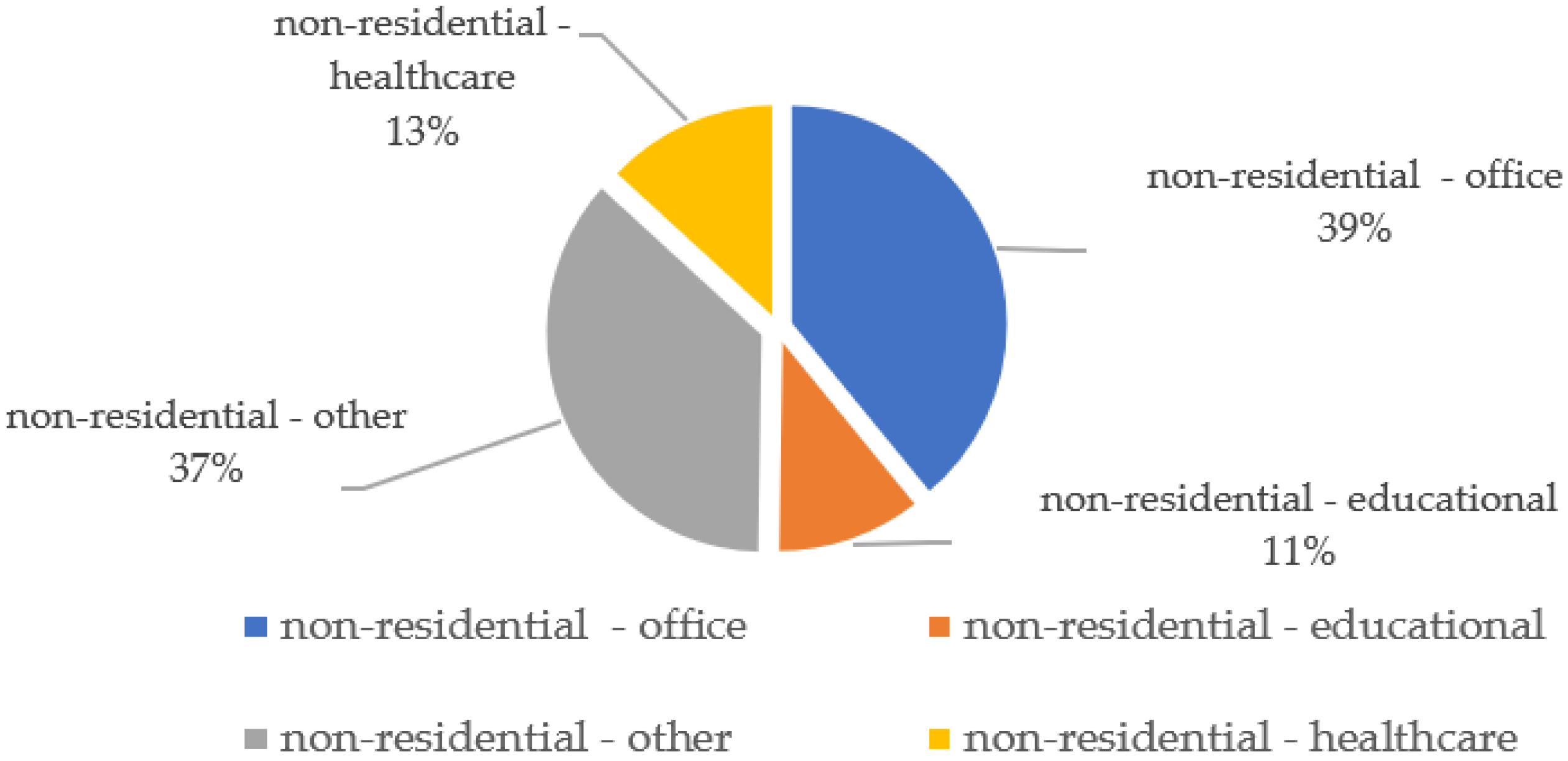
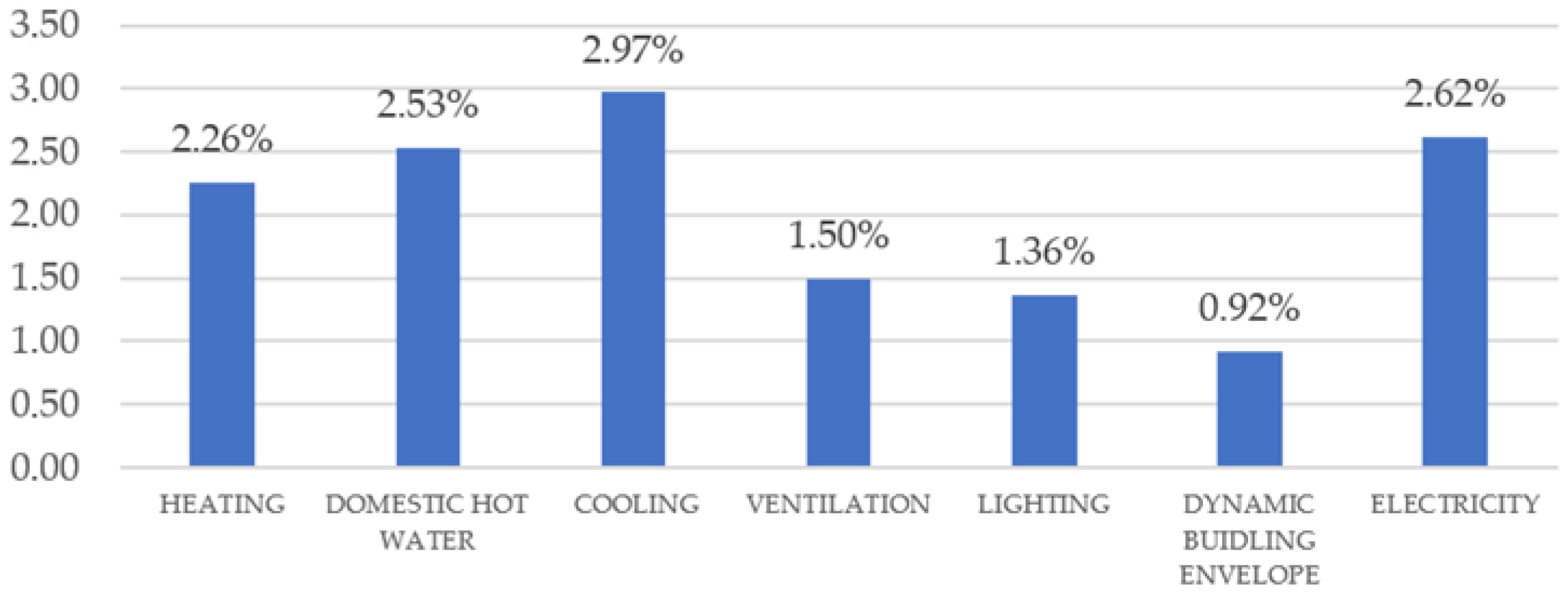
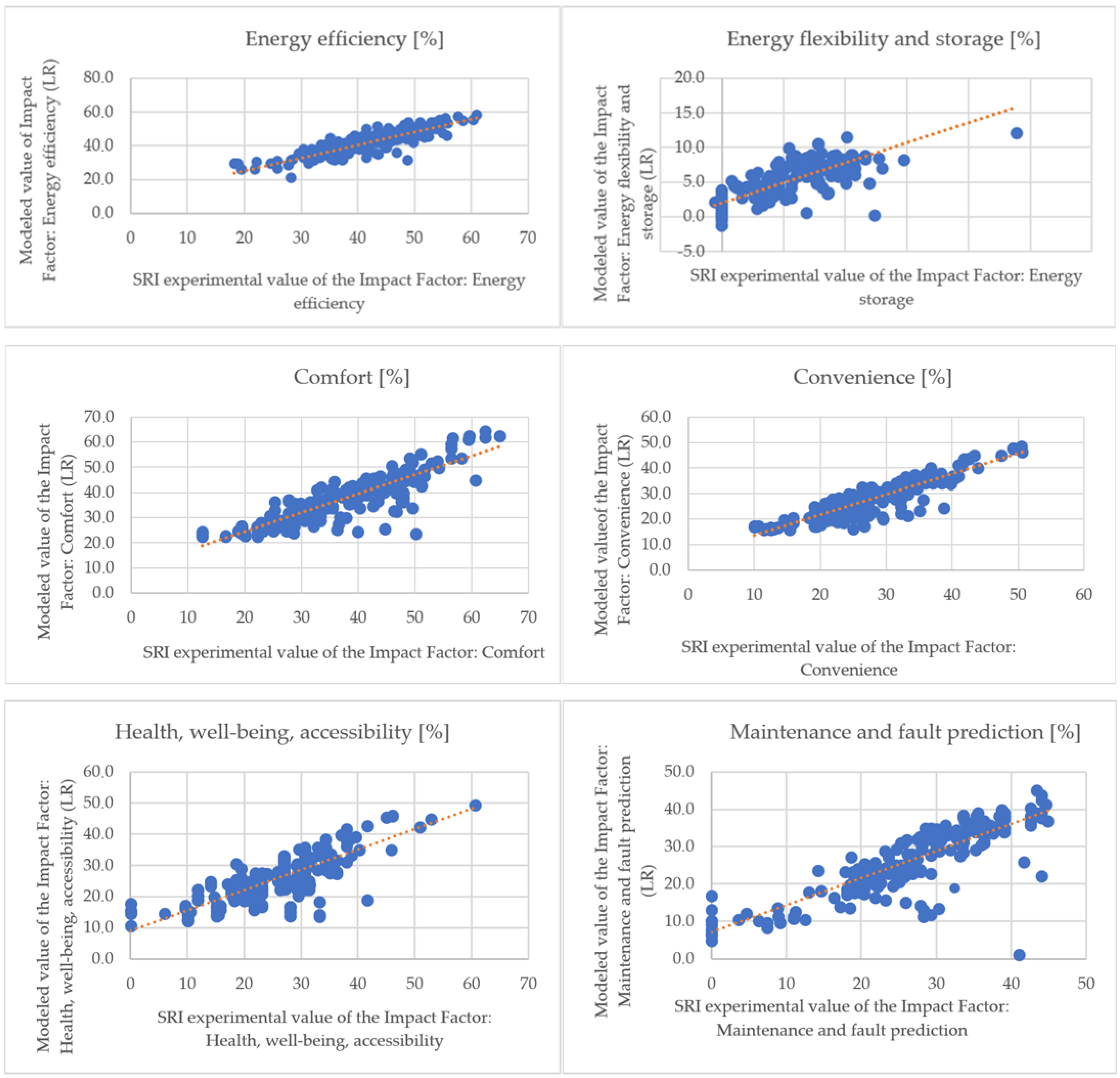
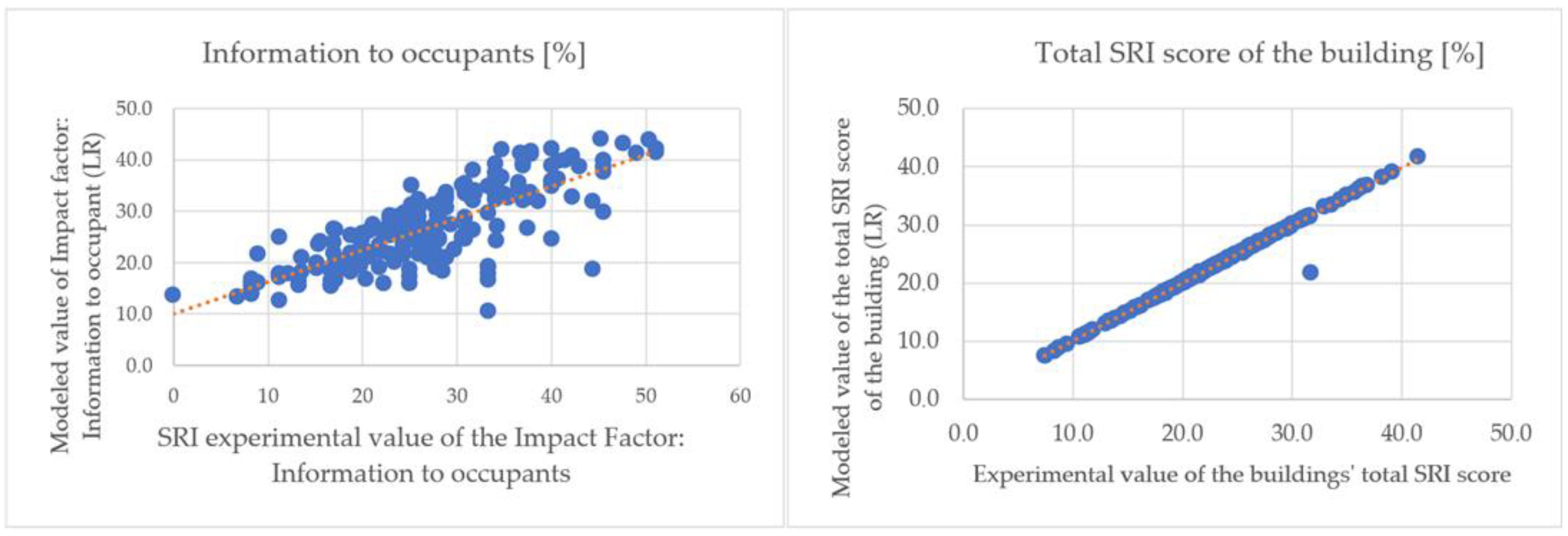
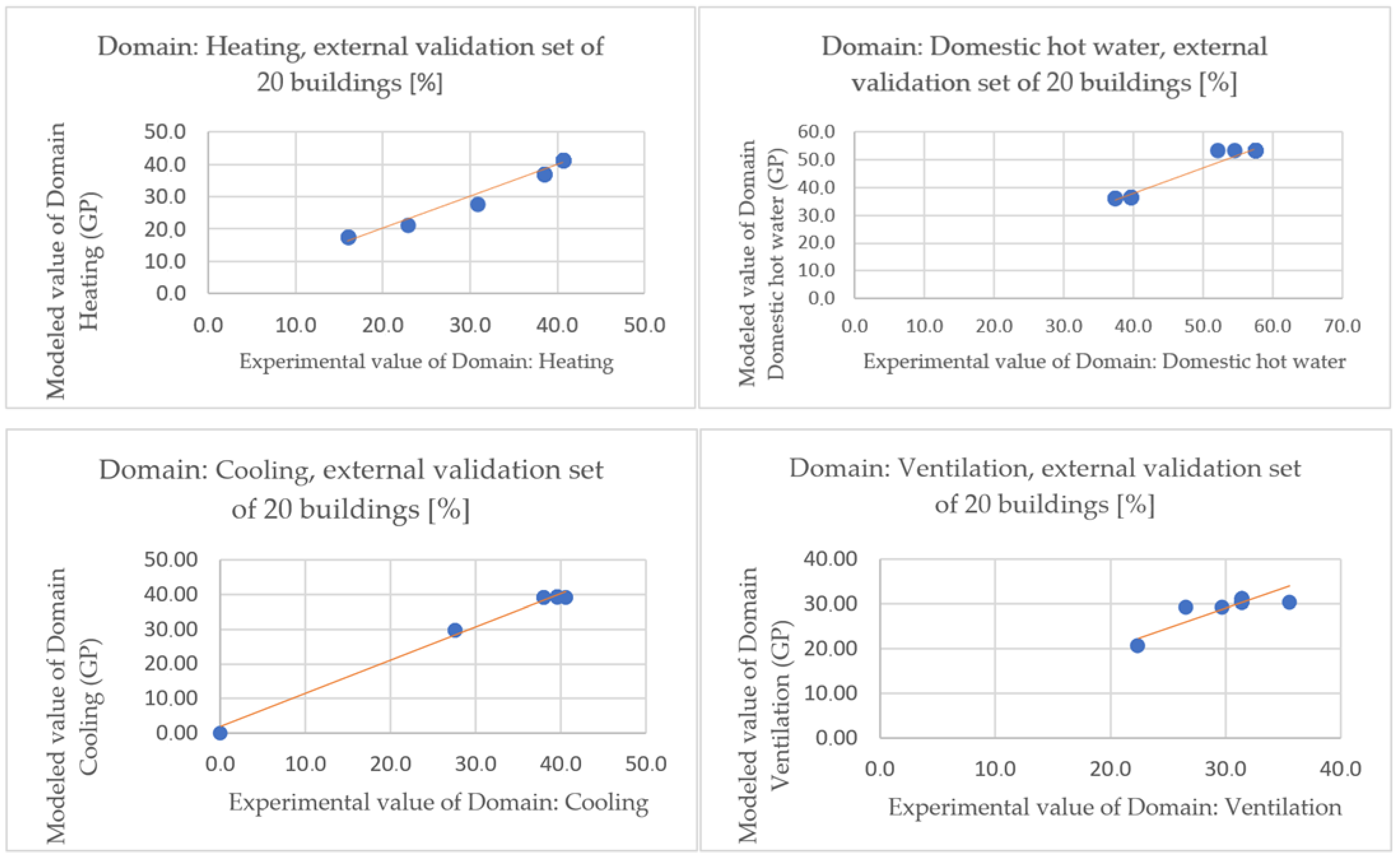
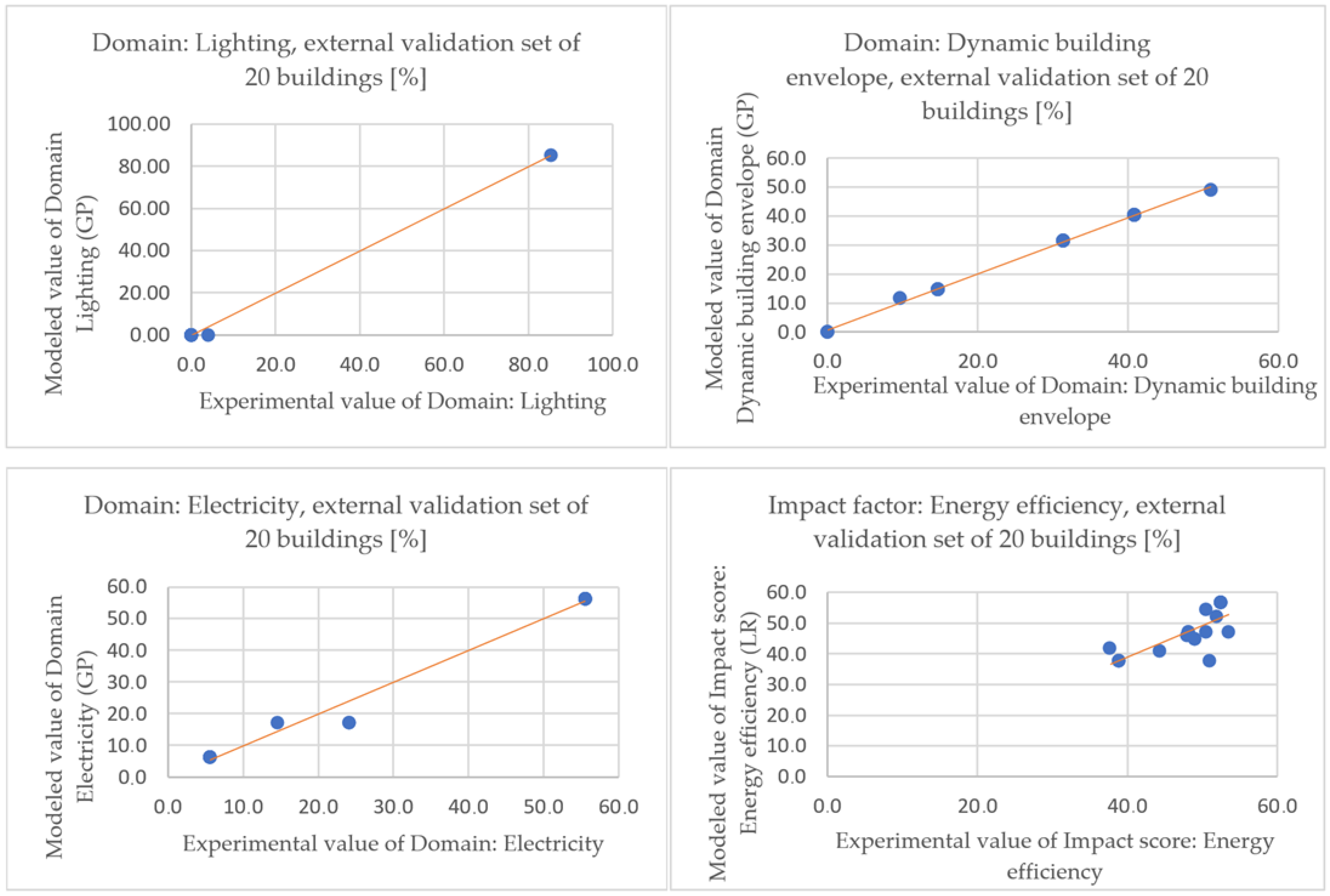

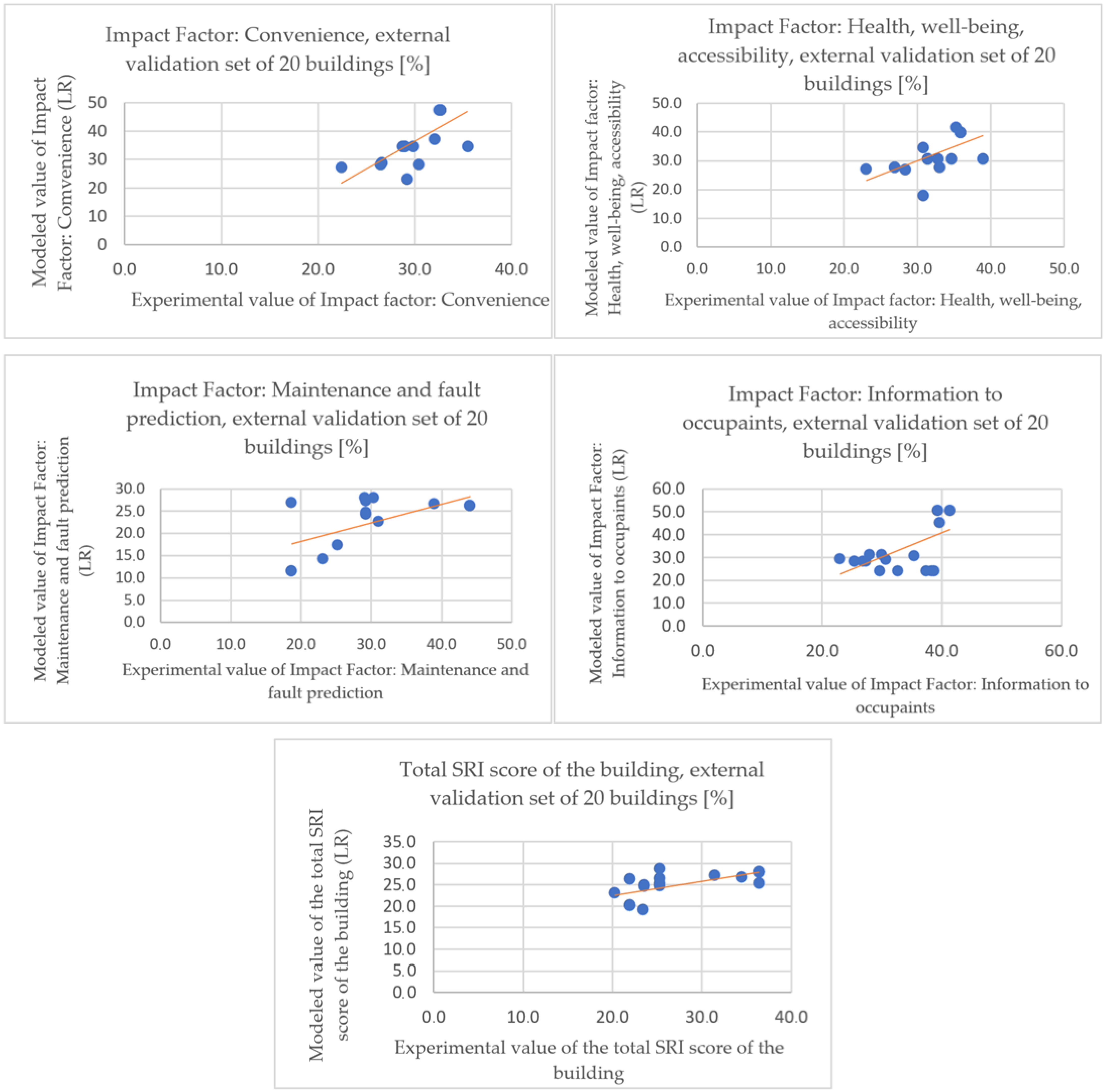
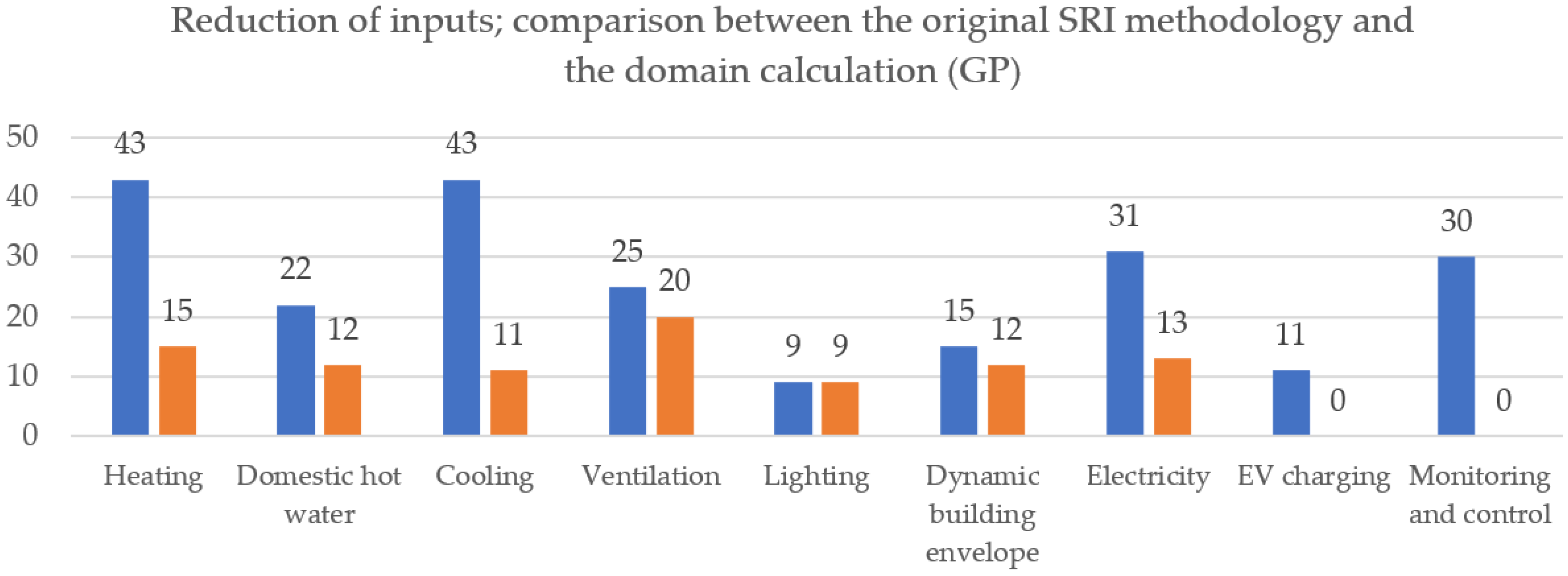
| Feature/Study | Markoska et al. [20] (2019)—PTing Framework + SRI Automation | Ye et al. [50] (2023)— SmartWatcher NLP | Carnero et al. [51] (2023) (INNOVA) | This Study (2025)— GP + LR Modelling |
|---|---|---|---|---|
| Assessment method | Rule-based scoring using metadata | NLP-based tool for interpreting system descriptions | IFC rule-checking for semi-automated SRI evaluation | Data-driven modelling using genetic programming (GP) + linear regression (LR) |
| Tool/ platform | Prototype software | Web-based platform with SmartWatcher engine | IFC-compatible BIM checking engine | Models work in Visual Basic, MS Excel, etc. |
| Data requirements | Structured metadata | Text descriptions of technical systems | Detailed and well-structured IFC models | Low to medium; works with basic SRI questionnaire input |
| Scope of SRI Domains | Broad but incomplete (based on the available metadata) | Covers most Domains where textual data exists | Mainly HVAC and electrical systems (~60–80% SRI coverage) | Two Domains not possible to model, namely EV charging and monitoring and control |
| Innovation highlighted | Metadata-based automation concept | First use of NLP for smartness evaluation | First IFC-based rule automation for SRI scoring | First GP + LR (reduces inputs) models trained on real-world, SRI evaluation of case studies (buildings) |
| Contribution | Early demonstration of automated logic for SRI assessment | Helped to automate SRI input interpretation using NLP | Showed how BIM files can partially automate an SRI evaluation | GP + LR models with reduced inputs that are transparent and trainable on different/expanded datasets, scalable |
| Category | Subcategories | Notes |
|---|---|---|
|
| |
|
| |
| This score has no subcategories | Considered as a single functional category |
| Case study buildings/ service level | “Heat emission control – no emission control” | “Heat emission control— Central automatic control (e.g., a central thermostat)” | “Monitoring and control – A single platform that allows automated control & coordination between TBS + optimisation of energy flow based on occupancy, weather, and grid signals” |
| LABEL | H1A1—first input | H1A2 | MC304—last input |
| Case study building 1 | 0 | 1 | 0 |
| Case study building 2 | 0 | 0 | 0 |
| Case study building 3 | 0 | 1 | 1 |
| Case study building 223 | 1 | 0 | 1 |
| Metric | Multiple R | R Square | Adjusted R Square | Standard Error | Observations |
|---|---|---|---|---|---|
| Energy efficiency | 0.874770679472713 | 0.765223741665151 | 0.755303618073538 | 4.01329710741988 | 223 |
| Energy flexibility and storage | 0.760022415639552 | 0.577634072274581 | 0.559787624624211 | 2.39055830607999 | 223 |
| Comfort | 0.867590952493899 | 0.752714060849271 | 0.742265359195015 | 5.33730508930646 | 223 |
| Convenience | 0.897960874717157 | 0.806333732522801 | 0.798150650798412 | 3.55794238372057 | 223 |
| Health, well-being, and accessibility | 0.809056679035984 | 0.654572709892735 | 0.639977190592428 | 5.571706763798932 | 223 |
| Maintenance and fault prediction | 0.850221379215518 | 0.722876393675137 | 0.711166945520566 | 5.94043101238427 | 223 |
| Information to the occupants | 0.786961162359672 | 0.619307871062485 | 0.603222288149632 | 6.09398014758909 | 223 |
| Total SRI score of the building | 0.994508935908173 | 0.989048023601207 | 0.988213587304157 | 0.685375906363476 | 223 |
| 1. Mean Absolute Error (MAE) | 2. Root Mean Squared Error (RMSE) | 3. Mean Bias Error (MBE) | 4. R2 (Coefficient of Determination) | 5. Pearson Correlation (r) | |
|---|---|---|---|---|---|
| DOMAINS | |||||
| 1. Heating | 1.30 | 1.41 | 0.09 | 0.98 | 0.99 |
| 2. Domestic hot water | 3.00 | 3.24 | −2.86 | 0.97 | 0.99 |
| 3. Cooling | 0.97 | 1.23 | 0.45 | 0.98 | 0.99 |
| 4. Ventilation | 1.24 | 1.69 | −0.99 | 0.83 | 0.91 |
| 5. Lighting | 0.20 | 0.89 | −0.20 | 1.00 | 1.00 |
| 6. Dynamic building envelope | 0.40 | 0.71 | −0.11 | 1.00 | 1.00 |
| 7. Electricity | 1.27 | 2.39 | −0.18 | 0.99 | 1.00 |
| IMPACT FACTORS | |||||
| 1. Energy efficiency | 3.60 | 4.52 | 0.87 | 0.59 | 0.77 |
| 2. Energy flexibility and storage | 1,94 | 2.25 | 0.16 | 0.84 | 0.92 |
| 3. Comfort | 3.56 | 4.89 | −2.28 | 0.42 | 0.65 |
| 4. Convenience | 6.98 | 8.80 | −6.06 | 0.54 | 0.73 |
| 5. Health, well-being, and accessibility | 3.69 | 4.68 | 0.03 | 0.42 | 0.65 |
| 6. Maintenance and fault prediction | 8.98 | 10.69 | −8.16 | 0.42 | 0.65 |
| 7. Information to occupants | 6.86 | 8.21 | −0.41 | 0.39 | 0.63 |
| TOTAL SRI SCORE | 4.45 | 5.5 | −3.0 | 0.48 | 0.69 |
| 1. Domains | 2. Impact Factors | 3. Total SRI Score of the Building | |
|---|---|---|---|
| Calculation method | GP | LR | LR |
| The necessary inputs for models | Smart services of the building (0,1,2, as described in Section 3.1) | Results of the Domains | Results of the Domains and Impact Factors |
| Number of “Smart-Ready” Service Levels in the Original Methodology | Number of Inputs (Organisms) in the Proposed GP Models | % Reduction of Inputs | |
|---|---|---|---|
| “Heating” | 43 | 15 | −65.12% |
| “Domestic hot water” | 22 | 12 | −45.45% |
| “Cooling” | 43 | 11 | −74.42% |
| “Ventilation” | 25 | 20 | −20.00% |
| “Lighting” | 9 | 9 | 0% |
| “Dynamic building envelope” | 14 | 12 | −20.00% |
| “Electricity” | 31 | 13 | −58.06% |
| “EV charging” | 11 | Not available | Not available |
| “Monitoring and control” | 30 | Not available | Not available |
| TOTAL: | 228 |
| Most Prominent Inputs (Appear in Models More than 15 Times) | ||
|---|---|---|
| Heating | “H31 None (No option for Central or remote reporting of current performance KPIs (e.g., temperatures, sub-metering energy usage)” “H2D2 Control according to a fixed priority list, e.g., based on rated energy efficiency” | |
| Domestic hot water | “DHW1A4 Automatic charging control based on local availability of renewables or Information from the electricity grid (DR, DSM)” | |
| Cooling | “C1F1 No interlock (between cooling and heating)” “C43 Self-learning optimal control of the cooling system” | |
| Ventilation | “V2D2 “Constant setpoint: A control loop enables to control the supply air temperature, the setpoint is constant and can only be modified by a manual” | |
| Lighting | “L23 Automatic switching” | |
| Dynamic building envelope | “DE22 Open/closed detection to shut down heating or cooling systems” | |
| Electricity | “EL124 Real-time feedback or benchmarking on appliance level” | |
Disclaimer/Publisher’s Note: The statements, opinions and data contained in all publications are solely those of the individual author(s) and contributor(s) and not of MDPI and/or the editor(s). MDPI and/or the editor(s) disclaim responsibility for any injury to people or property resulting from any ideas, methods, instructions or products referred to in the content. |
© 2025 by the authors. Licensee MDPI, Basel, Switzerland. This article is an open access article distributed under the terms and conditions of the Creative Commons Attribution (CC BY) license (https://creativecommons.org/licenses/by/4.0/).
Share and Cite
Beras, M.; Brezočnik, M.; Župerl, U.; Kovačič, M. Developing an Alternative Calculation Method for the Smart Readiness Indicator Based on Genetic Programming and Linear Regression. Buildings 2025, 15, 1675. https://doi.org/10.3390/buildings15101675
Beras M, Brezočnik M, Župerl U, Kovačič M. Developing an Alternative Calculation Method for the Smart Readiness Indicator Based on Genetic Programming and Linear Regression. Buildings. 2025; 15(10):1675. https://doi.org/10.3390/buildings15101675
Chicago/Turabian StyleBeras, Mitja, Miran Brezočnik, Uroš Župerl, and Miha Kovačič. 2025. "Developing an Alternative Calculation Method for the Smart Readiness Indicator Based on Genetic Programming and Linear Regression" Buildings 15, no. 10: 1675. https://doi.org/10.3390/buildings15101675
APA StyleBeras, M., Brezočnik, M., Župerl, U., & Kovačič, M. (2025). Developing an Alternative Calculation Method for the Smart Readiness Indicator Based on Genetic Programming and Linear Regression. Buildings, 15(10), 1675. https://doi.org/10.3390/buildings15101675





